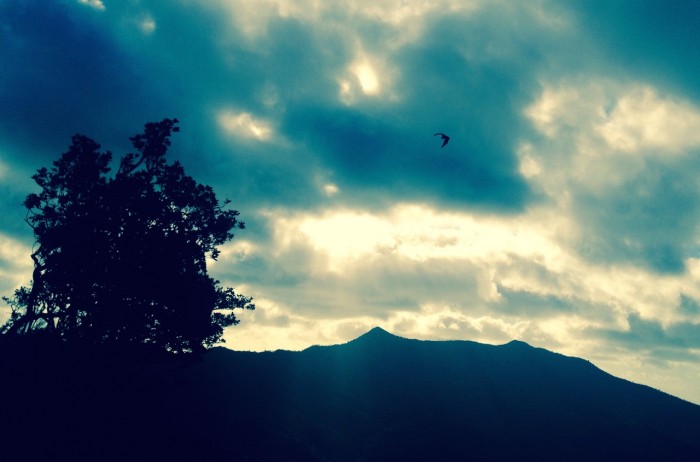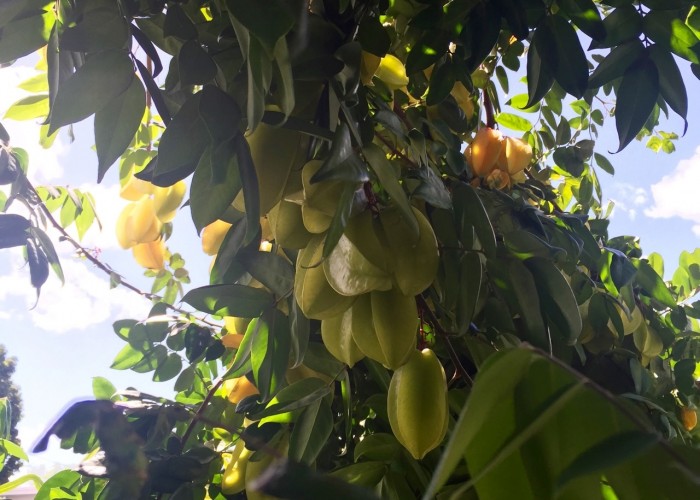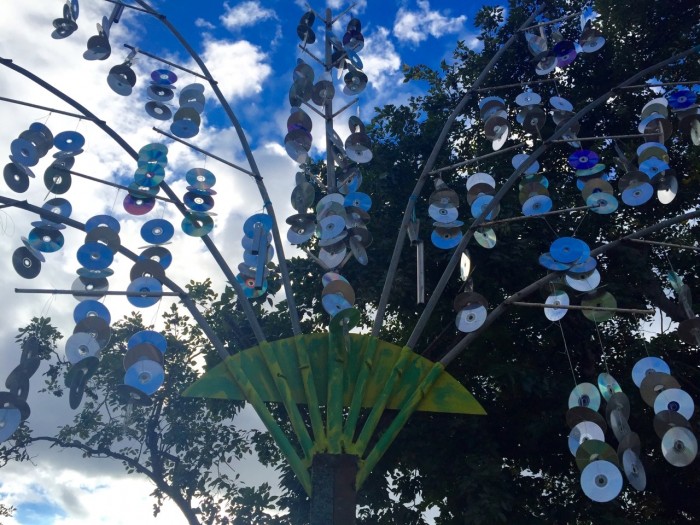This post is presented in this week’s series recognizing Earth Day, Friday, April 22.
“Qu’est-ce qu’on va faire à propos des chauves-souris?”
What are we going to do about the bats?
I sit among a small cluster of locals and expats as we sip on coffee and soft drinks sweetened by locally grown sugarcane. We are crowded around a collection of bistro tables pushed together in the center of a busy café. The tropical sky overhead is clear, with not a single cloud in sight. No birds. No bats either.
They came for the bats—not to kill them. No, we are here to discuss ways of relocating the unwelcome creatures elsewhere. Elsewhere could be anywhere—just as long it was away from the towns, away from the orchards. In short, away from humans.
In late 2015, the government of Mauritius issued a controversial cull of approximately 18,000 Pteropus niger—an endemic megabat species declared “vulnerable” by the World Conservation Union (IUCN) scarcely two years prior. Why would the Mauritian government be in favor of culling a species that has hovered between vulnerable and endangered status for the past thirty years (Cheke and Dahl 1981)? Where was the empirical research to support this decision (Florens 2015)? And what did competing agro-industry and conservation interests add to the story?

Nuisance animals and good neighbors
Pteropus niger, or the Mauritian flying fox, has swiftly entered the national discourse as a nuisance animal. Occupying a gray zone between pest and protected species, the bat has become arguably one of Mauritius’s most maligned creatures.[1] Life for the flying fox is not easy. As construction firms transform forest habitats into human-centric spaces—massive public infrastructure works, agro-industrial expansions, and shopping centers—flying foxes have learned to forage ever further afield. The consequence? Their subsequent encroachment into plantations, orchards, and urbanized areas has become a source of much frustration.[2]
Why was there so much pressure building around the cull? Fruit plantation owners lobbied for it vociferously. Conservationists and allies fiercely decried it. Where did public opinion lie?
This is not an easy question to answer. In brief, one could give the anthropologically unsatisfying response: “It’s complicated.” While public opinion is divided on the matter, in this post, I want to explore how human exceptionalism may fuel some of these views.
To many Mauritians, bats are no better than parasites: they feed off carefully tended fruit trees while offering little in return. Despite this misconception, as frugovores, flying foxes are intricately linked to the fecundity of their arborescent partners. They are prolific fruit tree pollinators, sowers of seeds, and makers of guano—a potentially valuable biofertilizer often rich in plant-loving phosphorus. Through these exchanges, flying foxes and fruit trees pollinate new naturecultures. Troubling rigidly defined boundaries, they weave together mutual affinities across species to engender new symbiotic intra-actions (Hustak and Myers 2012; see Haraway 1997).
Human exceptionalism prevents us from understanding our place in the world. Unlike bats or fruit trees, we see ourselves as social beings outside the realm of nature (see Latour 2004). Yet, as many anthropologists and science studies scholars have demonstrated, humans are already entangled with their environments—we mutually constitute each other (Barad 1996; Choy 2011; Cruikshank 2005; Stengers 2010). The challenge, then, is how to care about these worldings (Puig de la Bellacasa 2012).
The questions of how certain bodies become categorized as useful—which ones are wanted and which are easy to displace—lies at the heart of my dissertation. While studying the rise of bioeconomies in Mauritius, my doctoral research has been concerned with how cash crop models capitalize on the generative capacity of flora and fauna, rendering new forms of value out of residues and biowaste. In this post, I want to dwell on the value of things. I see these quick dismissals of P. niger as telling. They reveal how monetary value claims underwrite the worth of a life. Attuning into these implications may also disclose how urban natures themselves are made profitable.
Bodies That Matter
The gathering at the café had other concerns in mind. Comprised of individuals from diverse backgrounds, the group was united over its dissatisfaction with the government’s handling of the P. niger affair. Together, they convened in order to stage a bat rescue or relocation—though the precise version differs, depending on whom you ask.
The group chose to meet at Bagatelle, a mall recently built upon repurposed plantation lands.[3] Diffident toward the particulars of interspecies intra-actions, they focused instead on the practical logistics of their plan. They proposed to humanely remove the bats from urban centers. Uncomfortable with the cull but unwilling to leave the bats to their own devices, this group of mostly tech-savvy individuals intended to create urban “no-fly zones” for bats. Their aim: to construct an electronic apparatus that would serve as an ultrasonic bat repellent.[4] By frightening the bats, the group hoped to scare them back into the forest, leaving the towns and fruit plantations in human hands.
This story is quite telling. Cursorily, it reveals which types of creatures are welcome to live alongside humans and those which are not. Fruit trees, unlike fruit bats, are more readily recognizable in Mauritius for their productive capacity and economic potential. More, the fiction of removing bats from urban settlements ignores how humans already entangled with nonhumans in their environments (Braun 2002). There is no turning back. Put another way, a false divide perpetuates a nature-culture dualism where wilderness is contrasted against humanity and urban life (Swyngedouw 2009). Confronting this divide means unraveling the synthetic boundaries between humans, bats, and their environments.

Value of Surplus Things
Thinking about how bats’ bodies become marked as undesirable of course leads to other questions. How are bodies made productive in order to serve new capitalist imperatives in emergent bioeconomies? While flying foxes are now seen as pests, historically, they did offer up something almost worth their weight in gold: guano.
Mauritius, like other former colonies ensnared by global commodities trades of sugar, tea, and spice, was built on explicitly agricultural endeavors. These colonial projects of improving the land demanded agricultural expertise, forced labor, and agricultural inputs, such as fertilizers from guano. As colonization and the plantation system remade the Mauritian landscape (Grove 1995), so too did the bodies that labored upon it.
Sugar estates in the Mauritian plantation system were eminently powered by exploitation, relying on the coerced physical labor of slaves and indentured laborers (Allen 1999; Teelock 1998). But human bodies in this system were not the only ones that mattered. It would be remiss not to point out that nonhuman entities—sugarcanes, soil organic matter, as well as the birds and bats that supplied guano for fertilizer—were also exploited, albeit in drastically different contexts. My point is to demonstrate that flora and fauna were not only of ecological, but economic concern. In these systems, commodities derived from sugarcane, bats and birds did carry monetary worth—even if it was to fuel agribusiness.
Valuing “Useless Creatures”
In a recent New York Times opinion piece, Richard Conniff asked, how is wildlife made to matter? In other words, why must wildlife be given a value made comprehensible to human economic systems in order to make it a life worth saving?
Wary of reductionist discourses, Conniff cautions against the lure of framing creatures as “useful.” He suggests that usefulness is deception: [Usefulness] implies that animals matter only because they benefit humans, or because just possibly, at some unknowable point in the future, they might benefit humans. (2014) Conniff offers a strong argument. There is something dangerous about attaching a monetary value on nature, making land and beings productive in order to ascribe them worth. Instead of monetizing the value of living things, what are the sorts of resistances we can pose against value claims on nature? In reductive models of Nature writ large, ecology itself can seemingly be arrived at by simply adding up the sum of its parts (Harvey 1996: 153). This has deeply political implications. Nature, or the material world, becomes reduced to merely commodities and outside reproach (Swyngedouw 2009). Yet, as the Mauritian flying fox reminds us, this sort of rationalization is not absolute but is ripe for challenge.
Resisting the notion that bats must be useful to humans in order to have worth understands that the bats themselves contain multitudes beyond enumeration (Haraway 1988). By changing the conversation, bats challenge us to ask how “nature” is formed and to be managed, and what value it holds for Mauritians. Following the bats, perhaps we can change the conversation on the neoliberalization of nature.
What if resisting these changes means focusing on what David Harvey has called a deep ecology—one so entangled and imbued with networks of relations, that is impossible to commodify (1996: 153)? Resisting the desire to monetize bats and fruit trees, of Mauritian urban natures, new postures must come to the fore. Viewing naturecultures instead as a web of relations and not commodities in the making, is a political act. It is this focus on the dynamic relationships through which humans, nonhumans, and environments move together that serves as a first step toward confronting essentializing practices.

Coda: Blaming the Bats, Blaming Ourselves
Bats, it must be said, are not just simply bats in Mauritius. Figuratively speaking, the flying fox serves as synecdoche, a sardonic reflection of local social ills in material form. As comic relief, bats stand in the culprits of several transgressions. Are the fruit plantations yielding poor harvests? Blame the bats. Blackouts in the countryside? It’s definitely the bats. Blaming the flying foxes often is a tongue-in-cheek response that makes visible local discontents with global dilemmas.
It is far easier to accuse wildlife as pests and fruit thieves than to look at the underlying reasons why wildlife moves into urban settings. What are some of the issues? As a laundry list of pressure points, the bats help tell stories about dispossession and land displacement, skyrocketing food prices, and water shortages—all symptomatic global pressures in commodities markets that have manifested locally in particular ways. In this regard, it is easier to blame something “useless” than to confront social malaise head on.
Jessica Caporusso is a PhD candidate in the program of Social Anthropology at York University, Canada. Her dissertation explores the cultural politics of the environment and emerging bioeconomies in the Global South. Jessica is supported by scholarships from the Social Science and Humanities Research Council of Canada (SSHRC CGS-D) and by the Ontario Government (OGS).
All photos in this post are credited to the author.
Notes
[1] Depending on the audience, other nuisance creatures in Mauritius may range from rats, stray dogs and cats, monkeys, and sugarcane pests such as borers and grubs.
[2] Flying foxes in particular have received much negative attention given their penchant for locally desired fruits—lychee, mango, and papaya tend to be their treats of choice much to the chagrin of many Mauritians.
[3] It should be noted that before sugarcane cultivation, the Moka district was covered in endemic forest—similar to the habitats of P. niger (Grove 1995).
[4] One problem, however, as explained by a biologist in attendance: P. niger is a subspecies of megabat. These frugovores, unlike their microbat cousins, rely on vision and scent to move, not echolocation.
References
Allen, Richard. 1999. Slaves, Freedmen, and Indentured Laborers in Colonial Mauritius. Cambridge: Cambridge University Press.
Barad, Karen. 1996. “Meeting the Universe Halfway: Realism and Social Constructivism without Contradiction.” Pp. 161–194 in Feminism, Science, and the Philosophy of Science, ed. Lynn Hankinson Nelson and Jack Nelson.
Braun, Bruce. 2002. The Intemperate Rainforest: Nature, Culture, and Power on Canada’s West Coast. Minneapolis: University of Minnesota Press.
Cheke, Anthony, and J.F. Dahl. 1981. “The Status of Bats on Western Indian Ocean Islands, with Special Reference to Pteropus.” Mammalia 45, no. 2: 205–238.
Choy, Timothy K. 2011. Ecologies of Comparison: An Ethnography of Endangerment in Hong Kong. Durham, NC: Duke University Press.
Cruikshank, Julie. 2005. Do Glaciers Listen? Local Knowledge, Colonial Encounters and Social Imagination. Vancouver: UBC Press.
Florens, F.B. Vincent. 2015. “Flying Foxes Face Cull Despite Evidence.” Nature 530, no. 33.
Grove, Richard. 1995. Green Imperialism: Colonial Expansion, Tropical Island Edens and the Origins of Environmentalism, 1600–1860. Cambridge: Cambridge University Press.
Haraway, Donna J. 1997. Modest₋Witness@Second₋Millennium.FemaleMan₋Meets₋OncoMouse: Feminism and Technoscience. New York: Routledge.
Haraway, Donna J. 1988. “Situated Knowledges: The Science Question in Feminism and the Privilege of Partial Perspective.” Feminist Studies 14, no. 3: 575–599.
Harvey, David. 1996. Justice, Nature and the Geography of Difference. Cambridge, MA: Blackwell Publishers.
Hustak, Carla, and Natasha Myers. 2012. “Involutionary Momentum: Affective Ecologies and the Sciences of Plant/Insect Encounters.” Differences 23, no 3: 74–118.
Latour, Bruno. 2004. Politics of Nature: How to Bring the Sciences into Democracy. Cambridge, MA: Harvard University Press.
Lowe, Celia. 2006. Wild Profusion: Biodiversity Conservation in an Indonesian Archipelago. Princeton, NJ: Princeton University Press.
Puig de la Bellacasa, Maria. 2012. “Nothing Comes without Its World: Thinking with Care.” The Sociological Review 60 no. 2: 197–216.
Stengers, Isabelle. 2010. Cosmopolitics I. Minneapolis: University of Minnesota Press.
Swyngedouw, Eric. 2009. “The Antinomies of the Postpolitical City.” International Journal of Urban and Regional Research. 33 no. 3: 601–620.
Teelock, Vijaya. 1998. Bitter Sugar. Moka, Mauritius: Mahatma Gandhi Institute.
Cite as: Caporusso, Jessica. 2016. “The Trouble with Bats: Valuing Urban Naturecultures.” EnviroSociety, 21 April. www.envirosociety.org/2016/04/the-trouble-with-bats-valuing-urban-naturecultures.
